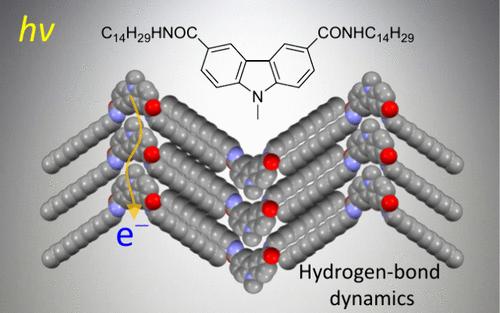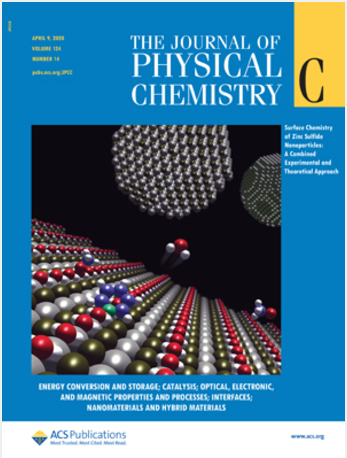Dynamic Polar Hydrogen Bonds and Photoconductivity of an Alkylamide-Substituted Carbazole Derivative
IF 3.3
3区 化学
Q2 CHEMISTRY, PHYSICAL
引用次数: 0
Abstract
Carbazole derivatives have long been known to exhibit excellent photoconductivity. Molecular arrangement control using intermolecular hydrogen bonds is an effective method for controlling carrier transport properties. In this work, we synthesized N,N′-ditetradecyl-9-methyl-3,6-carbazoledicarboxamide (C14CBC) by introducing two tetradecylamide (−CONHC14H29) chains into the 3,6-position of 9-methyl-carbazole and considered electronic structure, phase transition behavior, molecular assembly structure, dielectric property, and photoconductivity of C14CBC. C14CBC forms a 1D π-stacking column structure by intermolecular amide hydrogen bonding. C14CBC shows a solid–solid phase transition at 346 K and a melting point at 458 K. The temperature- and frequency-dependent dielectric constants show a response due to the dynamics of polar amide units above 400 K. The conductivity of the S1 and S2 phases is governed by the trap level and the HOMO–LUMO band gap. In the dynamic high temperature solid phase, the activation energy decreased upon photoirradiation.

烷基酰胺取代咔唑衍生物的动态极性氢键和光电导性
众所周知,咔唑衍生物具有出色的光电导性。利用分子间氢键控制分子排列是控制载流子传输特性的有效方法。在这项研究中,我们通过在 9-甲基咔唑的 3,6 位引入两条十四酰胺(-CONHC14H29)链,合成了 N,N′-二十四烷基-9-甲基-3,6-咔唑二甲酰胺(C14CBC),并研究了 C14CBC 的电子结构、相变行为、分子组装结构、介电性质和光导率。C14CBC 通过分子间酰胺氢键形成了一维π堆积柱结构。C14CBC 在开氏 346 度出现固-固相转变,熔点为开氏 458 度。随温度和频率变化的介电常数在开氏 400 度以上显示出极性酰胺单元的动态响应。在动态高温固相中,光照射时活化能降低。
本文章由计算机程序翻译,如有差异,请以英文原文为准。
求助全文
约1分钟内获得全文
求助全文
来源期刊

The Journal of Physical Chemistry C
化学-材料科学:综合
CiteScore
6.50
自引率
8.10%
发文量
2047
审稿时长
1.8 months
期刊介绍:
The Journal of Physical Chemistry A/B/C is devoted to reporting new and original experimental and theoretical basic research of interest to physical chemists, biophysical chemists, and chemical physicists.
 求助内容:
求助内容: 应助结果提醒方式:
应助结果提醒方式:


